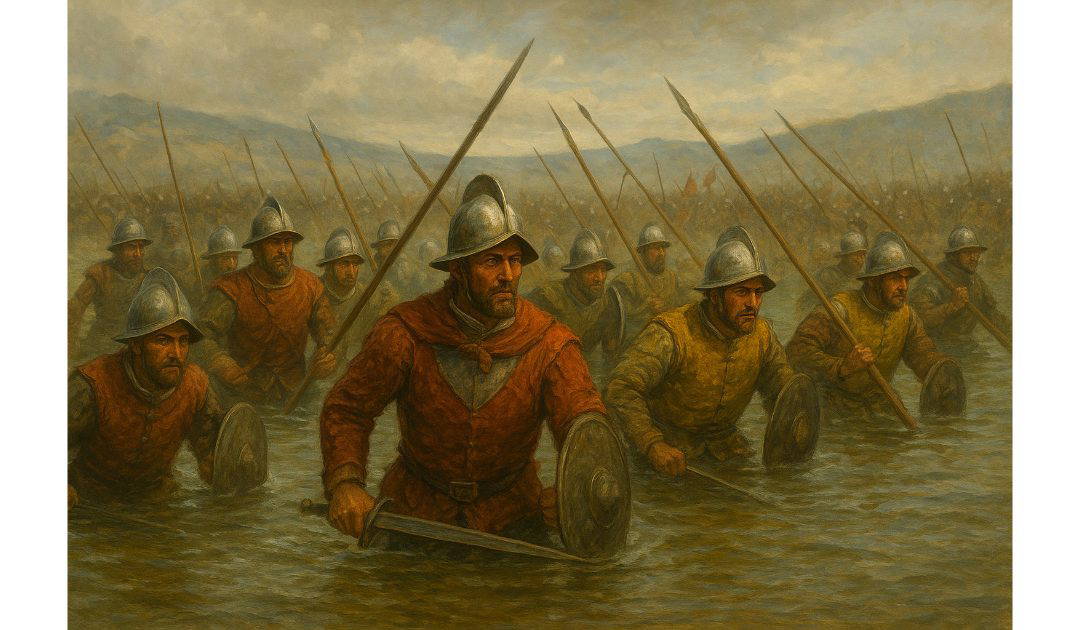The 20th of October was my father’s birthday. I’ve posted about my father a few times, so for today’s blog I shall write about the Relief of Goes, an amazing feat during the Eighty Years’ War, which was my ancestor Sir Anthony Standen’s war.
Context of the Conflict
The Eighty Years’ War began in 1568 as the Seventeen Provinces of the Low Countries sought to free themselves from the control of the Spanish Habsburg monarchy. Religious tensions between Protestant Reformers and the Catholic monarchy fuelled the conflict, alongside political discontent over Spanish-imposed taxation and centralisation efforts.
By 1572, the rebellion had gained momentum. The Sea Beggars (Watergeuzen), a group of Calvinist privateers and rebels, captured several key towns in the Netherlands, including Brielle. Their successes encouraged other towns to join the revolt. Goes, situated in the province of Zeeland, became a focal point due to its strategic position controlling access routes in the region.
The Siege of Goes
In the summer of 1572, Dutch rebel forces laid siege to Goes. The town was held by a Spanish garrison and loyalist forces under the command of Cristóbal de Mondragón, a seasoned Spanish officer. The rebels aimed to weaken Spanish control in Zeeland and secure a critical stronghold, which would bolster their access to maritime routes and reinforce connections with other rebel-held territories.
The siege was arduous, with the Dutch employing typical tactics of the time, such as cutting off supply lines and attempting to breach fortifications. Despite these efforts, the defenders of Goes held out, relying on their strong defensive position and dwindling supplies.
The Spanish Response and the Relief Effort
Recognising the importance of Goes, the Spanish authorities organised a relief effort. Cristóbal de Mondragón was entrusted with leading the operation. The challenge was formidable: the sea and surrounding waters, including the Eastern Scheldt, were controlled by rebel forces, and the terrain was treacherous due to the region’s intricate network of waterways, marshlands, and inundated areas.
Mondragón devised an audacious plan. Rather than attacking directly by land, which was heavily fortified and difficult to traverse, he decided to approach Goes by water. His strategy involved marching his troops through the shallow, tidal waters of the Eastern Scheldt during low tide—a perilous manoeuvre given the risk of drowning, exposure, and the unpredictable nature of the tides.
The Daring March Across the Waters
On the night of the 20th of October, 1572, Mondragón led around 3,000 soldiers in this daring amphibious operation. The troops waded through waist-deep, sometimes chest-deep waters, carrying their weapons and supplies above their heads to keep them dry. The march covered several kilometres across mudflats and shifting sands, all under the cover of darkness to avoid detection by the rebel forces.
This remarkable feat of endurance and discipline was successful due to meticulous planning, strong leadership, and the soldiers’ determination. Despite the harsh conditions, the Spanish troops reached Goes with minimal losses. Their sudden arrival took the besieging rebels by surprise.
The Lifting of the Siege
With the Spanish relief force attacking from within the town and loyalist troops defending from the walls, the rebel besiegers found themselves trapped between two fronts. The unexpected reinforcement shattered the morale of the Dutch rebels, forcing them to abandon the siege hastily.
The lifting of the siege marked a significant victory for the Spanish. It demonstrated their resilience, military ingenuity, and capability to maintain control over key strategic locations despite the growing strength of the rebellion. Cristóbal de Mondragón’s leadership was widely praised, and the operation became a celebrated example of tactical brilliance in military history.
Aftermath and Historical Significance
The Relief of Goes had both immediate and long-term implications. In the short term, it ensured continued Spanish control over Zeeland, maintaining crucial supply lines and maritime access. This victory allowed the Spanish to stabilise their position in the southern Netherlands, slowing the momentum of the Dutch revolt.
However, the broader tide of the Eighty Years’ War continued to shift. While the Spanish secured temporary advantages, the rebellion persisted. The resilience and determination exhibited by both sides exemplified the protracted and grueling nature of the conflict, which would continue until the Treaty of Westphalia in 1648, ultimately recognising Dutch independence.
Historians regard the Relief of Goes as a testament to the strategic ingenuity required in warfare, especially in challenging geographical conditions. It highlights the importance of leadership, the element of surprise, and the ability to adapt to environmental constraints.

